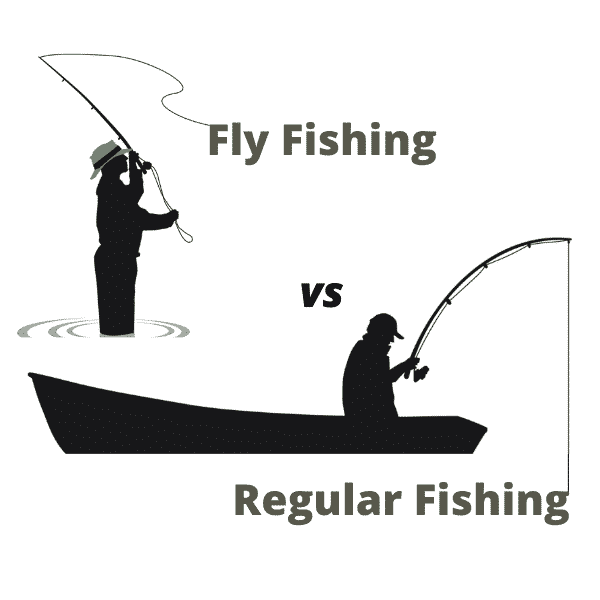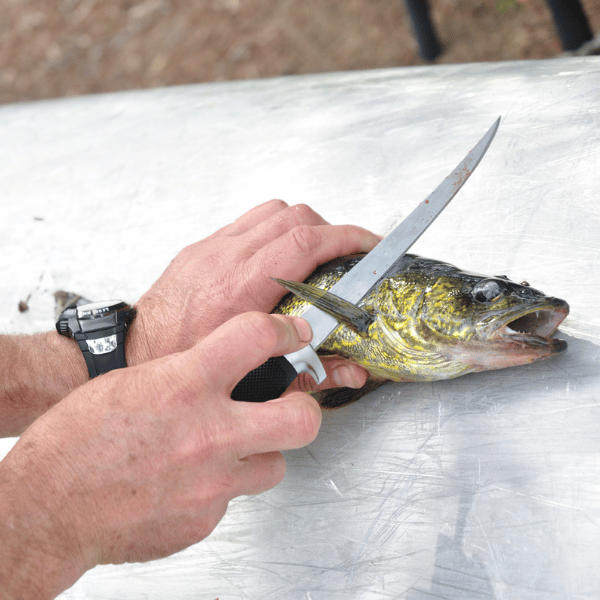Differences Between Fly Fishing vs Regular Fishing

When you see someone fly fishing, there’s a certain grace and elegance to it. The way the line moves through the air can have a hypnotic effect, particularly when handled by a skilled angler. Regular fishing, on the other hand, doesn’t have the same panache. You cast a line and reel it in. If you want to get fancy, maybe you use a trolling or jigging motion.

Artistic concerns aside, why do some people prefer fly fishing, while others prefer a traditional cast-and-retrieve fishing method?
Is one of them more effective? More fun? Better for different types of fish?
As we’ll see, a lot of this comes down to preference, and to what you want to get out of a day of fishing. Now, let’s break down the differences between fly fishing vs. regular fishing. Once you know what sets them apart, you’ll be better able to decide which one is the right choice for you. Let’s begin!
Contents
Difference Between Fly Fishing & Regular Fishing
The first difference anyone notices between fly fishing and regular fishing is how you actually cast the line. Fly fishing requires broad, lazy looping, while normal fishing involves either casting and retrieving or trolling. The reason for this difference is where the weight is located.

In regular fishing, you use a lure or bait, sometimes combined with a lead weight, to propel the line. However, fly fishing relies on very small bait, and weights would be counterproductive since they might spook the fish. Instead, the weight of the line itself is used to draw it out of the reel. Hence, the wide, sweeping motions associated with fly fishing.
Regular fishing is generally easier if you want to cover more water quickly. Because casting and retrieving takes only seconds, you can experiment and find where the fish are biting. In addition, because you can use heavier lures, you have a wider variety of options. Crankbaits and jerkbaits, for instance, can only be used with a regular fishing rod and reel. Try to use them with your fly rod, and you won’t get any results.
Fly fishing, on the other hand, offers a more realistic bait. This is particularly true for fish like trout that prefer insects. There’s simply no way to realistically simulate a fly with a regular fishing rod!
You’re not confined to fishing only trout, either. In fact, fly fishing is great for catching any fish that prefers insects, and you can even simulate small baitfish like minnows to catch non-insect-eating species.
Similarly, fly fishing can be done in either fresh or saltwater, just like regular fishing. That said, just as with regular fishing, you’ll want sturdier equipment to catch larger saltwater fish.
An attendant difference between fly fishing and regular fishing is that fly fishing generally requires less tackle. In many cases, you can carry your supplies in a few vest pockets, instead of needing to carry 20 different large lures.
Is Fly Fishing Harder Than Regular Fishing?
As you can see, there are plenty of gear differences between fly fishing and regular fishing. But at the end of the day, the equipment follows the same basic concepts. You have a rod, a reel, some line, and a lure. What makes one fishing method different from the other is how you use that equipment.
To start with, let’s look at your typical fly rod. A fly rod is normal than a regular fishing rod, typically measuring at least nine feet long. They’re very slender, and they’re made to flex easily under tension. This is because of the casting method required for using a fly fishing rod.

The basic mechanics of any cast are relatively straightforward. As you move the rod backward, it flexes backward, storing up potential energy. When you move the rod forward, it flexes forward, releasing that energy and adding a bit of zoom to the end of the line.
But the lightweight nature of a fly lure makes building up momentum more complicated than it appears at first. Because a fly rod relies on the weight of the line to build momentum, you have to start slowly. At first, not much line has been released, there isn’t much weight on the tip of the rod. As a result, the rod doesn’t flex very much, and doesn’t contribute much energy on the forward stroke.
A well-engineered fly rod will maximize both the potential and kinetic energy. With plenty of flex, it will bend at least a little bit under the lightest load. And with their long lengths, the rods allow you to move the tip faster than you could with a shorter rod. A long rod also helps to keep more line out of the water, and a dry line is easier to manage.
Over the course of several sweeping movements, the line slowly unreels, increasing the amount of weight on the rod. This allows you to flick the surface with a lure, rather than splashing and reeling it in. More advanced techniques include hauling on the line to make the rod bend further, but that’s something you’ll learn after you’ve mastered the basics.
The hardest thing about fly fishing is learning to understand this casting technique. While learning to cast a regular rod takes only minutes, it can take hours to successfully cast a fly line. It can take several more outings to truly master the technique. In a sense, fly fishing is like anything else worth doing: it requires practice. But once you get the hang of it, it’s no harder than casting an ordinary fishing line.
With all of that being said, it’s undeniable that casting a regular rod is much simpler. Similar to a fly rod, the regular rod is springy, and the weight on the line causes it to bend backward, then snap forwards.
However, regular rods use a much heavier lure and sometimes lead weights as well. As a result, the rod can bend very easily under stress. For this reason, regular rods tend to be shorter and less flexible than fly rods. This allows you to cast your line a long distance, without the corresponding wide casting motion of a fly rod. You simply sweep the rod backward, then forward to release.
As you can see, regular fishing isn’t necessarily easier than fly fishing, just easier to pick up. With practice, you can become equally skilled at either method.
When is Fly Fishing Better than Regular Fishing?
Fly fishing can be superior to regular fishing for many reasons. To begin with, you can fish in conditions that would not work with a regular rod. Imagine you’re trout fishing, and the water is as smooth as glass. If you cast a regular line over that fish, it’s going to get spooked by the lure and swim away instead of striking. With a fly rod and reel, you can drop a dry fly right next to the trout without spooking it. If your technique is on point, you can target individual fish as you desire.
On a related note, fly fishing lets you use bait that won’t work on a regular line. Many fish are picky. If a certain type of bug or baitfish is in season, they oftentimes won’t eat anything else. With a fly fishing rig, these bugs and small baitfish become practical lure options.
Fishing is about more than just catching fish. It’s about enjoying the outdoors and spending time in nature. Because of its slower, more relaxed pace, fly fishing gives you the opportunity to take a breather and feel at peace. You might not be hauling in as many big lunkers, but for many people, the thrill of the catch is just a small part of the fishing experience.
Last but not least, fly fishing is far more ethical than catch and release fishing. Large lures with triple hooks can cause severe injury to fish. Oftentimes, with these lures, a straightforward catch-and-kill would arguably be more humane than catch-and-release. Fly lures are smaller and have far less impact on the fish. This in turn means that the stock will be healthier for other anglers.
When is Regular Fishing Better than Fly Fishing?
Of course, regular fishing comes with its own attendant benefits. For one thing, as we already mentioned, you can use crankbaits and jerk baits. These baits are ideal for many species and help you reach deeper in the water column than a fly rig will reach.
This makes regular fishing more straightforward for most species of fish. For pretty much anything other than trout, a regular angler will catch more weight than an equally-skilled fly fisherman.
Regular fishing may not have the same artistic and humanitarian merits as fly fishing. And while it might be relaxing, it doesn’t have the same slow, lazy pace as fly fishing. But it’s the best way to catch as many fish as possible, as quickly as possible. This is doubly true if you plan on eating your catch, since damage due to hooks will be less of a concern.




